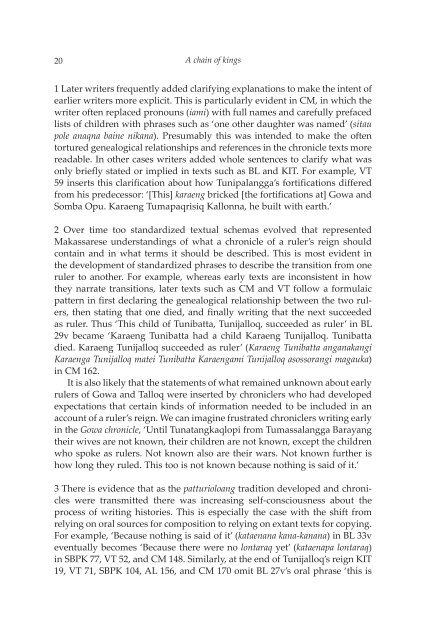A CHAIN OF KINGS - Books and Journals
A CHAIN OF KINGS - Books and Journals
A CHAIN OF KINGS - Books and Journals
You also want an ePaper? Increase the reach of your titles
YUMPU automatically turns print PDFs into web optimized ePapers that Google loves.
20<br />
A chain of kings<br />
1 Later writers frequently added clarifying explanations to make the intent of<br />
earlier writers more explicit. This is particularly evident in CM, in which the<br />
writer often replaced pronouns (iami) with full names <strong>and</strong> carefully prefaced<br />
lists of children with phrases such as ‘one other daughter was named’ (sitau<br />
pole anaqna baine nikana). Presumably this was intended to make the often<br />
tortured genealogical relationships <strong>and</strong> references in the chronicle texts more<br />
readable. In other cases writers added whole sentences to clarify what was<br />
only briefly stated or implied in texts such as BL <strong>and</strong> KIT. For example, VT<br />
59 inserts this clarification about how Tunipalangga’s fortifications differed<br />
from his predecessor: ‘[This] karaeng bricked [the fortifications at] Gowa <strong>and</strong><br />
Somba Opu. Karaeng Tumapaqrisiq Kallonna, he built with earth.’<br />
2 Over time too st<strong>and</strong>ardized textual schemas evolved that represented<br />
Makassarese underst<strong>and</strong>ings of what a chronicle of a ruler’s reign should<br />
contain <strong>and</strong> in what terms it should be described. This is most evident in<br />
the development of st<strong>and</strong>ardized phrases to describe the transition from one<br />
ruler to another. For example, whereas early texts are inconsistent in how<br />
they narrate transitions, later texts such as CM <strong>and</strong> VT follow a formulaic<br />
pattern in first declaring the genealogical relationship between the two rulers,<br />
then stating that one died, <strong>and</strong> finally writing that the next succeeded<br />
as ruler. Thus ‘This child of Tunibatta, Tunijalloq, succeeded as ruler’ in BL<br />
29v became ‘Karaeng Tunibatta had a child Karaeng Tunijalloq. Tunibatta<br />
died. Karaeng Tunijalloq succeeded as ruler’ (Karaeng Tunibatta anganakangi<br />
Karaenga Tunijalloq matei Tunibatta Karaengami Tunijalloq asossorangi magauka)<br />
in CM 162.<br />
It is also likely that the statements of what remained unknown about early<br />
rulers of Gowa <strong>and</strong> Talloq were inserted by chroniclers who had developed<br />
expectations that certain kinds of information needed to be included in an<br />
account of a ruler’s reign. We can imagine frustrated chroniclers writing early<br />
in the Gowa chronicle, ‘Until Tunatangkaqlopi from Tumassalangga Barayang<br />
their wives are not known, their children are not known, except the children<br />
who spoke as rulers. Not known also are their wars. Not known further is<br />
how long they ruled. This too is not known because nothing is said of it.’<br />
3 There is evidence that as the patturioloang tradition developed <strong>and</strong> chronicles<br />
were transmitted there was increasing self-consciousness about the<br />
process of writing histories. This is especially the case with the shift from<br />
relying on oral sources for composition to relying on extant texts for copying.<br />
For example, ‘Because nothing is said of it’ (kataenana kana-kanana) in BL 33v<br />
eventually becomes ‘Because there were no lontaraq yet’ (kataenapa lontaraq)<br />
in SBPK 77, VT 52, <strong>and</strong> CM 148. Similarly, at the end of Tunijalloq’s reign KIT<br />
19, VT 71, SBPK 104, AL 156, <strong>and</strong> CM 170 omit BL 27v’s oral phrase ‘this is









![Am HaSefer [Volk des Buches] - Books and Journals](https://img.yumpu.com/20648352/1/174x260/am-hasefer-volk-des-buches-books-and-journals.jpg?quality=85)







